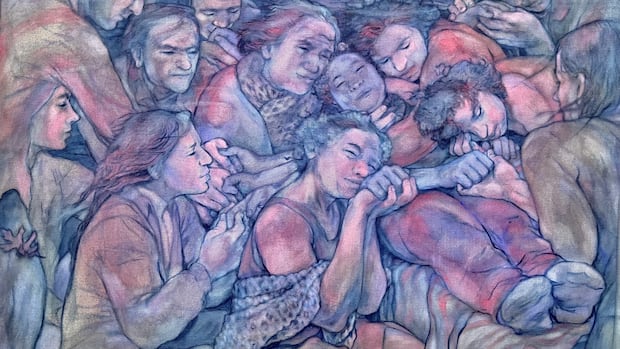ArtsAt OAG, The Art of a Good Death brings palliative-care research into the public realm through painting, film and an interactive exhibit. The show, created by Ottawa researcher Sarina Isenberg with artists from across Canada, asks an unsettling question: What does it mean to die well?At the Ottawa Art Gallery, artists turn end-of-life research into something tender, haunting and human — and sNickie Shobeiry · CBC Arts · Posted: Nov 08, 2025 8:00 AM EST | Last Updated: 2 hours agoListen to this articleEstimated 5 minutesThe audio version of this article is generated by text-to-speech, a technology based on artificial intelligence.Aimee-Rose Philibert’s Vent de Melisse, part of The Art of a Good Death. (Courtesy of Ottawa Art Gallery)In a ghost town in B.C.’s Kootenays with five dogs at her feet, Aimee-Rose Philibert paints in her driveway studio — her small museum of “weird, obscure art and biology.”“Sometimes I fight with a painting,” she says. “After a bit, suddenly, it’s like the image in my brain is what I have in front of me.” One of her works, Vent de Melisse, is part of an upcoming exhibit, The Art of a Good Death, running Nov. 8 to Jan. 11 at the Ottawa Art Gallery (OAG). The exhibition will tour other cities in Canada in 2026.It was inspired by a close friend, Melisse, who had Huntington’s disease and chose to have a medically assisted death. To celebrate her last days, Melisse invited around 30 of those closest to her; to a chalet in a Quebec forest. They barely slept, playing music, dancing, eating “luscious food” and taking advantage of those last moments with her. On the day Melisse had chosen, a doctor arrived at the chalet. “It was awful because we were losing a friend, but so strong and empowering — so beautiful and intense,” Philibert says.“She went very fast and seemingly comfortably. Everyone came to her and embraced her. The scene was perfect.”Philibert’s painting — cool neutral tones capturing both joy and heartbreak — was one of three winners of a competition led by Sarina Isenberg, a palliative-care researcher at the University of Ottawa and Bruyère Health Research Institute. Jennifer Kershaw’s In Excelsis Doughnut, part of The Art of a Good Death. (Richard Murphy)Isenberg and her team invited artists across the country to interpret the findings on what makes a good death, including physical comfort, emotional peace, connection, autonomy and dignity.She wanted to take the research on death out of academic journals and conferences and bring it into the public realm. “It integrates my science brain with my arts brain and establishes common humanity across these spheres, which aren’t mutually exclusive,” she says. More than 100 submissions came in from nine provinces. “We laughed — we cried,” Isenberg says. “Some were literal; some abstract. It was a really emotional experience for myself and the other adjudicators.” The jury of curators, scientists, health-care providers and caregivers chose six artworks for the show, including a coffin-shaped sculpture made of found materials, a graphic novel, stills from a film and a bouquet of flowers and medical devices. There will also be an interactive exhibit in the form of a sapling, where visitors can share how they’d like to die. The sapling will then come back to the gallery as a full tree, with each leaf, flower and fruit representing the survey findings.As the OAG’s director and CEO, Alexandra Badzak aims to bridge the gap between art and health. “Artists are in this space, so a public art gallery needs to be there to support,” she says. Sarina Isenberg (Courtesy Sarina Isenberg)She says artists are able to interpret complex topics in a way that allows people in, to wit: Ottawa artist Jennifer Kershaw’s glossy still life of doughnuts and ice cream, In Excelsis Doughnut. It’s a tongue-in-cheek reference to the hymn Gloria in Excelsis Deo, which translates to “Glory to God in the highest.” The piece was inspired by the food people requested when they were dying, including Kershaw’s grandmother who, while in hospital with terminal cancer, longed for a homemade cinnamon-sugar doughnut. In her artist statement, Kershaw writes that the treat was forbidden by the hospital, so her mother smuggled one in.And when Kershaw’s mentor, Bill, was dying of cancer, he requested snacks over flowers and was enjoying raspberries the last time she saw him. When a friend’s mother was in hospice care, it was ice cream that brought comfort.“It came across as a very important aspect of agency at the end of these people’s lives,” Badzak says. “It’s a delightful, wonderful, slightly ironic piece of artwork.” The six works approach the idea of a good death in different ways, but they all make death more accessible. “It provides a softer opening for a conversation that otherwise can be quite jarring to initiate,” Isenberg says. And the crux of that conversation, according to Philibert, is that death isn’t a “horror story.” “Love your homies,” she says. “Don’t miss showing the people you love that you love them.”The Art of a Good Death runs until Jan. 11 at the Ottawa Art Gallery (50 Mackenzie King Bridge) in Ottawa.ABOUT THE AUTHORNickie Shobeiry is a writer, film and radio producer, covering arts, culture and social impact in Canada and beyond. As a second-generation Iranian raised in England and now living in Ottawa, she’s always looking for ways to create space for unheard stories and voices.
Wednesday, 24 Dec 2025
Canada – The Illusion
Search
Have an existing account?
Sign In
© 2022 Foxiz News Network. Ruby Design Company. All Rights Reserved.
You May also Like
- More News:
- history
- Standing Bear Network
- John Gonzalez
- ᐊᔭᐦᑊ ayahp — It happened
- Creation
- Beneath the Water
- Olympic gold medal
- Jim Thorpe
- type O blood
- the bringer of life
- Raven
- Wás’agi
- NoiseCat
- 'Sugarcane'
- The rivers still sing
- ᑲᓂᐸᐏᐟ ᒪᐢᑿ
- ᐅᑳᐤ okâw — We remember
- ᐊᓂᓈᐯᐃᐧᐣ aninâpêwin — Truth
- This is what it means to be human.
- Nokoma











